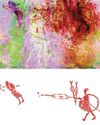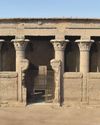A cemetery used for centuries is an expression of the enduring relationship between the living and the dead.

One of archaeology’s paradoxes is that in order to comprehend ancient people’s lives, often the best place to look is not through the broken sherds of the pots they used to cook their family dinners, or at what may be left of their homes after hundreds or even thousands of years, but in their graves. How people are buried, the things they are buried with, and their physical remains can reveal much about those who might otherwise be lost to history. Are their graves filled with valuable items that mark them as wealthy, or with only a few small treasured possessions? Or were they interred with nothing at all and simply consigned to the earth? Did they succumb to a common disease, or were they casualties of war? Do their bones show the passage of many years, or did they die young?
Burials can also illuminate cultural circumstances and values. “People’s bodies can tell us a great deal about them as biological individuals,” says mortuary archaeologist Kate Emery of the George Eastman Museum in Rochester, “but bones also have a lot to say about them as social individuals.” The materials available, the types of coffins chosen, the inclusion of provisions for the afterlife, and even the position of the deceased’s body are testimony to economic realities and to belief systems that can be difficult to detect in the writings of ancient authors. “Excavating the dead is actually very humanizing compared to a text,” says Emery. “For the most part we don’t know anything about who they were or many details about them, so studying their bodies and what they chose—or what mourners chose—to put around them in death adds a richness to the story of the past that is missing. Text allows us to remove ourselves from people in some way, but when you are actually looking at their bodies and considering who they were, it’s very intimate.”
هذه القصة مأخوذة من طبعة March/April 2017 من Archaeology.
ابدأ النسخة التجريبية المجانية من Magzter GOLD لمدة 7 أيام للوصول إلى آلاف القصص المتميزة المنسقة وأكثر من 8500 مجلة وصحيفة.
بالفعل مشترك ? تسجيل الدخول
هذه القصة مأخوذة من طبعة March/April 2017 من Archaeology.
ابدأ النسخة التجريبية المجانية من Magzter GOLD لمدة 7 أيام للوصول إلى آلاف القصص المتميزة المنسقة وأكثر من 8500 مجلة وصحيفة.
بالفعل مشترك? تسجيل الدخول

A Very Close Encounter
New research has shown that human figures painted in red on a rock art panel in central Montana depict individuals engaged in a life-or-death encounter during an especially fraught historical moment.

A Sword for the Ages
A zigzag pattern, now tinged with the green-blue patina of oxidized metal, adorns the octagonal hilt of a rare sword dating to the Middle Bronze Age in Germany (1600-1200 B.C.) that was recently excavated in the Bavarian town of Nördlingen.

Ancient Egyptian Astrology
For centuries, layers of soot have coated the ceilings and columns in the entrance hall of Egypt's Temple of Esna. Now, an Egyptian-German team of researchers, led by Hisham El-Leithy of the Egyptian Ministry of Tourism and Antiquities and Christian Leitz of the University of Tübingen, is restoring the temple's vibrant painted reliefs to their original brilliance.

BRONZE AGE POWER PLAYERS
How Hittite kings forged diplomatic ties with a shadowy Greek city-state

RITES OF REBELLION
Archaeologists unearth evidence of a 500-year-old resistance movement high in the Andes

Secrets of Egypt's Golden Boy
CT scans offer researchers a virtual look deep inside a mummy's coffin

When Lions Were King
Across the ancient world, people adopted the big cats as sacred symbols of power and protection

UKRAINE'S LOST CAPITAL
In 1708, Peter the Great destroyed Baturyn, a bastion of Cossack independence and culture

LAPAKAHI VILLAGE, HAWAII
Standing beside a cove on the northwest coast of the island of Hawaii, the fishing village of Lapakahi, which is surrounded by black lava stone walls, was once home to generations of fishers and farmers known throughout the archipelago for their mastery of la'au lapa'au, or the practice of traditional Hawaiian medicine. \"

A MORE COMFORTABLE RIDE
Although the date is much debated, most scholars believe people 5,000 years ago. For thousands of years after that, they did so without saddles. \"In comparison with horse riding, the development of saddles began relatively late, when riders began to care more about comfort and safety in addition to the horse's health,\" says University of Zurich archaeologist Patrick Wertmann.